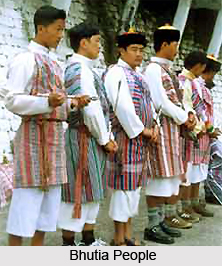 The Bhutias are evenly distributed throughout the state of Sikkim. In Northern Sikkim, where they are the major inhabitants, known as the Lachenpas and Lachungpas. The Lachenpas and the Lachungpas who mainly inhabit the areas around Lachen and Lachung respectively have their own traditional legal system known as Zamsa to settle disputes. Zamsa means public meeting place and the village headman, who is also known as the Pipon metes out justice and is chosen once in a year by the villagers voting by the show of hands. The Pipon takes all decisions regarding the village life like when the crops should be harvested. The Bhutia aristocrats are known as the Kazis. The language spoken by the Bhutias is Sikkimese and as a matter of fact this is a dialect of Tibetan language. The script is the same. Bhutias constitute about ten percent of the total population of Sikkim. Bhutia villages are large as those compared to those of Lepchas.
The Bhutias are evenly distributed throughout the state of Sikkim. In Northern Sikkim, where they are the major inhabitants, known as the Lachenpas and Lachungpas. The Lachenpas and the Lachungpas who mainly inhabit the areas around Lachen and Lachung respectively have their own traditional legal system known as Zamsa to settle disputes. Zamsa means public meeting place and the village headman, who is also known as the Pipon metes out justice and is chosen once in a year by the villagers voting by the show of hands. The Pipon takes all decisions regarding the village life like when the crops should be harvested. The Bhutia aristocrats are known as the Kazis. The language spoken by the Bhutias is Sikkimese and as a matter of fact this is a dialect of Tibetan language. The script is the same. Bhutias constitute about ten percent of the total population of Sikkim. Bhutia villages are large as those compared to those of Lepchas.



















